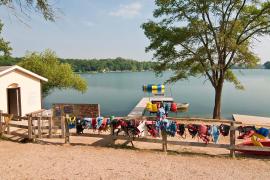When camp season began in the spring of 2022, The Redwoods Group consultants heard multiple concerns from our camp insurance customers about safety.
Whether it was difficulty in hiring and retaining staff, challenges in effectively training the staff that camps did have, or managing campers who had not been exposed to a camp or school environment for a while, camp directors were very aware that this was likely to be one of the most challenging camp seasons they had faced. Now that the season is behind us, we wanted to take a moment to review how those concerns played out in practice — and to draw out any lessons we could learn from for the future.
According to Sarah Palestine, a Redwoods senior technical consultant, one of the reasons why so many within the camp community were concerned was simple — we were all having to play catch-up after the pandemic’s disruptions:
When COVID hit, we were all forced to scramble in the face of an unprecedented disruption. We had to rethink almost everything we did. That necessarily forced us to focus on COVID-specific details like creating pods, managing isolation of sick or exposed campers, and defining or enforcing masking and vaccine policies. It was such a focus in 2021, that once 2022 rolled around, there were elements of broader camp safety that really needed to be prioritized or refreshed.
A Heroic Challenge
The concern we were hearing from camps, Palestine says, was not that broader safety issues were being forgotten. But rather that the pandemic had added multiple additional layers of stress, complication, distraction, and disruption to the already challenging task of keeping camp safe. Camps had done a great job in learning how to keep campers safe from the virus in 2021, but now they were coming back to camp in 2022 and discovering new and sometimes unpredictable challenges related to the broader experience and societal impact of life in a global pandemic:
We heard from camps that they were being forced to do more, with the same or even fewer resources than they had had before. The waterfront has always been a potentially dangerous place, but it becomes exponentially more so when you have campers who haven’t been swimming in a while. Similarly, peer abuse and bullying have always been a concern at camp, but we know for a fact that it’s more of a concern when children are traumatized, or lonely, or have not learned how to behave in the company of others. Now on top of all that, we add a tight labor market and a general shortage of staff. It’s hard to exaggerate how challenging that looked in the Spring of 2022 to many of the camp staff we were talking to.
Missing Soft Skills
Katie Johnson, a Redwoods senior consultant and former camp director, remembers a number of conversations with camp directors and frontline staff from the start of the summer. While some reported very specific challenges — like a shortage of lifeguards, for example — others were more focused on a general sense that relationships and behavioral norms had shifted since the pandemic began:
I remember one director telling me that they could easily look at any group and see who was isolated during COVID and who wasn’t. This tended to lead to more campers who had small incidents or accidents, as they were just not used to things like “running with a group,” or even just sitting next to each other without getting into trouble. This wasn’t just related to campers. Younger staff were also interacting with leadership differently. The usual processes of observing their work and providing feedback just didn’t seem as effective anymore. There were just some “soft” social skills missing that really got in the way of working as a team.
So how did the camp community do in the face of these challenges? What lessons can be drawn from what did — and what did not — happen at camp in 2022?
Frequency Breeds Severity
According to both Palestine and Johnson, it’s important to be cautious when looking for statistical signals around safety. There are simply too many contributing factors to any single incident. It can also take years for trend lines, either positive or negative, to make themselves apparent.
That said, conversations with camp leadership across the country do provide some anecdotal evidence that concerns were justified, says Johnson:
Undoubtedly, camps did heroic work last summer. And I was mightily relieved that we didn’t have as many major incidents as we had feared. Staff and leadership deserve a lot of praise for that. But I think most of them would agree with me that we also got lucky. There was a general sense from the camps we work with that the number of minor incidents was up. And what we know about minor incidents is that the more frequent they are, the more likely it is that one of them will become major. “Frequency breeds severity” is kind of a mantra for us.
Looking back on the year, both Johnson and Palestine point to several common themes they observed or heard about during their visits and phone calls with camps across the country. These included:
- Multiple Demands on Leadership: From supervising ropes courses to watching the waterfront, the shortage of staff meant leadership sometimes had to step in to perform frontline safety tasks, sometimes while multitasking to manage the day-to-day running of camp. That led to the potential for distraction, particularly in high-risk situations where 100 percent focus is needed.
- Behavioral Issues among Campers: Whether it was bullying, fights, or inappropriate behavior, many camps reported challenges with behavior management among campers who had been isolated at home. And as every camp director knows, minor behavioral issues can easily escalate — especially when group dynamics kick in.
- Increased Frequency of Auto Incidents: From drivers running off the road to minor collisions in the parking lot, the staff shortage led to increased reliance on fewer drivers. While we were lucky not to see any fatalities or serious injuries, there were several close calls.
The good news, say both Palestine and Johnson, is that camps have and are implementing common solutions that will help to address the themes already outlined.
Engaged Supervision
The first, says Johnson, is to double down on supervision — making sure that counselors and staff are engaging with campers, including during downtimes and transition times when behavioral issues can often arise. That may mean spending some time to reflect on and improve how you are teaching and constantly reinforcing effective supervision practices and protocols.
Equally important in ensuring this supervision is effective, says Palestine, is making sure that staff have frequent breaks and rotations — and that staff or leadership supervising high-risk activities are singularly focused on the task at hand.
Continuous Training
The second solution Palestine points to is to rethink and reimagine our approach to training. While trainings have often previously been “front-loaded” in the camp season — with long training sessions at the beginning of the year — the camps that Redwoods works with are hearing from camp directors that this traditional approach is no longer as effective. Instead, the growing consensus is a focus on continual, frequent refreshers and interventions — using staff meetings, in-service drills, and short “mission moments” to make sure safety is front-of-mind at all times. Directors know this. But, sometimes, staff need reminders.
This also involves a shift from the traditional mid- and end-of-season feedback sessions to a more continual process of demonstrating to staff how specific tasks can be effectively performed.
Leadership Presence
Lastly, both Johnson and Palestine pointed to the need for camp leadership to close the gap between protocols and practices — most notably by making sure they are observing actual practices on a regular basis. Whether it’s riding along with a new driver or observing lifeguards at the waterfront, the goal of these observations isn’t simply staff accountability, says Johnson. It’s also about making sure camp directors are aware of the reality their staff is facing so that they can direct resources to where they are needed — or adjust programming if necessary:
We know that staff are doing incredible work with very few resources. But not all of them feel knowledgeable or empowered enough to make sometimes tough calls on safety. This leads to a situation where directors may think staff are doing one thing — for example, closing the climbing wall when there are not enough staff available for belaying without taking adequate breaks. In practice, staff may not want to disrupt camp operations, and feel like they need to “keep the show on the road.” Camp directors, on the other hand, may walk into a situation and know immediately that it’s time to shut down the ropes course or cancel horseback riding for the day.
Ultimately, both Palestine and Johnson argue that the lessons of 2022 are mixed. On the one hand, it is testament to the dedication and professionalism of the camp community that we got through one of the most challenging seasons that camps have ever faced — and that hundreds of thousands of campers were once again able to safely enjoy community, adventure, and growth together after being isolated at home. On the other hand, some very real and present challenges and some serious close calls could easily have ended differently. As we look to the upcoming camp season, we know that the challenges are not going away. We also know, however, that many of the same heroes who got us through 2022 will be applying what they have learned to make camp better, more exciting, and safer than it ever has been before.
Sami Grover develops safety-related content for The Redwoods Group and is the author of We’re All Climate Hypocrites Now, an exploration of the role of personal responsibility in solving the climate crisis.
Photo courtesy of Camp Carson in Princeton, Indiana
The views and opinions expressed by contributors are their own and do not necessarily reflect the views of the American Camp Association or ACA employees.




